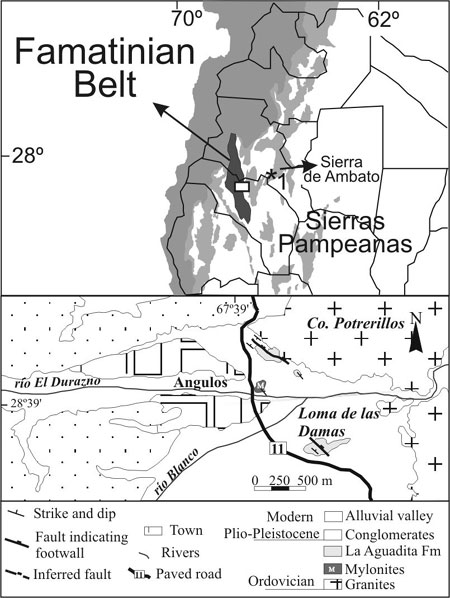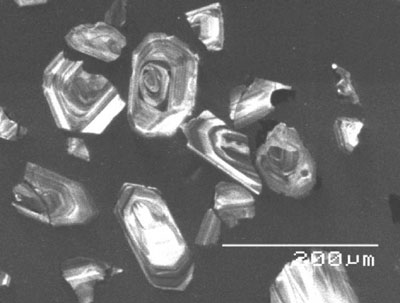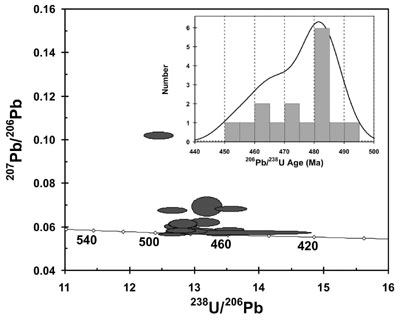
Ordovician back–arc clastic wedge in the Famatina Ranges: new ages and implications for reconstruction of the proto–Andean Gondwana margin
Ricardo A. Astini1, Federico M. Dávila1, Carlos W. Rapela2, Robert J. Pankhurst3 and C. Mark Fanning4
1Cátedra de Estratigrafía y Geología Histórica, Universidad Nacional de Córdoba Avenida Vélez Sársfield 299, 5000 Córdoba, Argentina. CONICET. E–mail: raastini@com.uncor.edu
2 Centro de Investigaciones Geológicas, Universidad Nacional de La Plata, 644 Calle Nº 1, 1900 La Plata, Argentina. CONICET.
3 NERC Isotope Geosciences Laboratory, British Geological Survey, Keyworth, Nottingham NG12 5GG, United Kingdom.
4 Research School of Earth Sciences, The Australian National University, Mills Road, Canberra, ACT 0200, Australia.
Key words: Detrital zircons. Ocloyic clastic wedge. Ordovician. Famatina. Western Argentina.
Introduction
New Early Ordovician (ca. 480 Ma) U–Pb ages have been obtained by ion–microprobe (SHRIMP) analysis of detrital zircon from the La Aguadita Formation of western Argentina, previously considered to be Late Precambrian–Early Cambrian (Durand et al., 1992). Sedimentological observations show that this siliciclastic unit has suffered major overburden and is affected by very low–grade regional metamorphism. It crops out along the eastern slope of the main Sierra de Famatina (in the present day broken foreland), to the west of Angulos in the La Rioja Province, (28º39’46" S, 67º38’00" W, Figure 1). It is composed of an alternation of thick packages (2–5m) of coarse arkoses and rhythmic intervals, where thin– to medium–bedded sandy storm layers punctuate green silty shales. Petrographical and stratigraphic observations on the extremely unsorted, coarse–grained epidote–rich arkoses (feldspathic sandstones) allow interpretation of the La Aguadita Formation as relicts of an Ocloyic clastic wedge (within the Famatinian Cycle) developed in a back–arc setting and representing a younger depositional system than the well dated Early–early Middle Ordovician volcano–sedimentary cycle.
Geochronology
Zircons were separated at the NERC Isotope Geosciences Laboratory, UK and poured onto a microprobe mount to avoid preferential selection. U–Pb dating was carried out using sensitive high–resolution ion microprobes (both SHRIMP I and SHRIMP RG) at The Australian National University, Canberra (Williams, 1998). Cathodo–luminescence imaging of the detrital zircons shows that they represent a homogeneous, possibly monogenetic, igneous population with well–formed crystal shapes and regular oscillatory zoning (Figure 2). The U–Pb data were processed using Isoplot/Ex (Ludwig, 1999) and are plotted in a Tera–Wasserburg diagram (Figure 3). The common–Pb corrected 238U–206Pb ages (inset) show some scatter within a restricted Ordovician range (450–490 Ma). The younger ages in the range could well be due to a small amount of Pb–loss, and the majority are within error of a single value (480 ± 5.7 Ma), consistent with common provenance from a single igneous source. This average age is considered to date the crystallisation of the source rocks, and is typical for the granitic magmatism of the Famatinian belt throughout this region (e.g., Pankhurst et al., 2000, and references therein).

Figure 1. Sketch relief map of the Central Andean region with location of La Aguadita Formation (1) type section in Famatina, Western Argentina, broken foreland. Also marked is the outcrop of La Cebila Formation (2) mentioned in the text.
Detrital modes of the La Aguadita Formation show high epidote contents, consistent with derivation from TTG and I–type metaluminous granitoid suites such as those described in the Famatinian belt. Absence of any mixture with different age and compositional sources indicates both that exhumation occurred short after granitoid intrusion and in a proximal setting. Restored paleocurrents and sandstone provenance argue for derivation from the west into a proximal foredeep. Back–arc foreland deposits with typical molasses were unknown at this latitude in relation to the Famatinian Orogen, because of greater exhumation of the southern part of the Famatina belt (Astini, 1999).
Discussion and Conclusions
These new ages further support the two–phase evolution recently postulated for the Famatinian belt by Rapela et al. (2001), as follows: a) Early Ordovician main intrusive period (Famatinian granites) between 490–470 Ma, largely contemporaneous with cogenetic arc volcanism, and b) late Early to late–Mid Ordovician moderate crustal thickening and related metamorphism (470–460 Ma). Rapid exhumation of deep roots of the Famatinian magmatic arc, possibly through broad extension (Rapela, 2000a), would have favoured limited production of post–orogenic sediments. The model envisaged is compatible with tectonic denudation and development of detachment faults during rapid collapse after crustal thickening (e.g., Dewey, 1988; Dalziel and Brown, 1989). A recently discovered east–dipping normal ductile shear zone (Dávila, 2001), which affects granites cropping out immediately east of Angulos town and carries the La Aguadita Formation metasediments on the upper–plate allows a core–complex interpretation (cf. Davis, 1983). Such crustal thinning can abruptly redistribute large loads from the elevated region without generating large amounts of sediment in response to isostacy (Burbank and Anderson, 2000). It can also explain high rates of bedrock uplift (England and Molnar, 1990), consistent with rapid unroofing of granites to provide the studied arkoses. However, it is no longer clear that rapid unloading and erosional thinning have to be associated with normal faulting (e.g., Hodges et al., 1998) and documented erosion rates are fast enough to accommodate nearly all of the documented rates of unloading (Burbank et al., 1996).

Figure 2. Cathodo–luminescence image of detrital zircons form the La Aguadita Formation, showing euhedral grains with concentric oscillatory zoning, indicating igneous zircons that have undergone little transport from the source.
Both folding and closure of the best–known Famatina inter–arc basins (Astini, 1998) are suggested by a major unconformity recorded in the hinterland (Dávila et al., 2003). Age distribution, trace element and isotopic signals indicate that the Famatinian belt was built on continental crust with inherited signatures pointing to derivation from Pampean cycle materials (Pankhurst et al., 1998, 2000; Rapela et al., 1998, 1999; Rapela, 2000b). The absence of older Gondwanan or Grenville inherited ages suggest restricted dispersal patterns consistent with juvenile drainage systems within proximal depositional environments. At the same time, the narrow error range of the zircon age population, together with poor sorting of the sandstones, suggests local derivation and deposition soon after Early Ordovician emplacement of the source rocks. In particular, the fact that there is no mixture with zircons from ca. 470 Ma granites, which are also common in this part of the Famatinian belt (Pankhurst et al., 2000), suggests deposition before the end of Mid–Ordovician times, thus implying relatively high rates of exhumation and unroofing (in the order of few mm/year). This would allow obtaining further constraints for the age of accretion of the Precordillera terrane to the proto–Andean margin.

Figure 3. Tera–Wasserburg plot of SHRIMP data from the analysed sample. The inset shows a relative probability plot of the common–Pb corrected ages.
Detrital zircon data by ICP–MS have recently become available from the La Cébila Formation (Finney et al., in press), ~100 km farther east in Catamarca Province (Figure 1). The youngest ages show a peak at 500 Ma (range 480–520 Ma), similar to those of the La Aguadita Formation at 480 Ma. However, older Neoproterozoic–Mesoproterozoic ages are represented (e.g., ~560, ~600, ~700, ~1200, ~1300 Ma) indicating a more varied range of Gondwana sources, consistent with more mature geomorphological stages and wider drainage–system coverage with a broad east–west dispersal. The relative coincidence in the younger populations could suggest tentative correlation between these two units, which occur across–strike in present coordinates. Similar units cropping out along the east slope of the Famatina belt have formerly been considered part of the basement and were correlated either with Late Proterozoic–Early Cambrian Puncoviscana Formation of northwest Argentina (Durand and Aceñolaza, 1990; Durand et al., 1992, Aceñolaza et al., 1999) or, alternatively, with the Cambrian Mesón Group (Espisúa and Caminos, 1979). More recently, these units were collectively included in the Las Termas belt (Söllner et al., 2001). The new zircon data rule out stratigraphic ages older than Early Ordovician for these sedimentary successions, the estimated minimum source age falling within the Arenig. Although later disruption and metamorphism have affected these units, preventing a proper paleoenvironmental reconstruction, preliminary interpretation suggests a double–source foreland setting. Thus, the internal depozone, represented in Famatina, show a west–east directed proximal source from exhumed granites toward the hinterland, whereas the more external reaches in Catamarca were sourced from east to west, hence showing a combination of Ocloyic and older Gondwanan provenance.
A conclusion resulting from our study is that these metasedimentary successions can be safely assigned to a sedimentary package, most probably unroofed to the south, non–conformably lapping on earlier Pampean age rocks.
References
Aceñolaza, F.G., Aceñolaza, G.F. and Esteban, S. 1999. Bioestratigrafía de la Formación Puncoviscana y unidades equivalentes en el NOA. In: González Bonorino, G., Omarini, R. and Viramonte, J. (Eds.), Geología del Noroeste Argentino, Relatorio del 14º Congreso Geológico Argentino. Salta: 91–114.
Astini, R.A. 1998. El Ordovícico en la región central del Famatina (provincia de La Rioja, Argentina): aspectos estratigráficos, geológicos y geotectónicos. Revista de la Asociación Geológica Argentina, 53(4): 445–460.
Astini, R.A. 2000. El ambiente geotectónico del Ordovícico de la región del Famatina. Réplica. Revista de la Asociación Geológica Argentina, 55(1–2): 136–138.
Astini, R.A. 1999. El Ordovícico del Sistema del Famatina. In: González Bonorino, G., Omarini, R y Viramonte, J. (Eds.), Geología del Noroeste Argentino. In: González Bonorino, G., Omarini, R. and Viramonte, J. (Eds.), Geología del Noroeste Argentino, Relatorio del 14º Congreso Geológico Argentino. Salta: 152–159.
Burbank, D.W. 1992. Causes of recent Himalayan uplift deduced from deposited patterns in the Ganges basin. Nature, 357: 680–682.
Burbank, D.W. and Anderson, R.S. 2000. Tectonic Geomorphology. Blackwell Science, Oxford: 1–274.
Burbank, D.W., Leland, J., Fielding, E., Anderson, R.S., Brozovic, N, Reid, M.R. and Duncan, C. 1996. Bedrock incision, rock uplift, and threshold hillslopes in the northwestern Himalaya. Nature, 379: 505–510.
Dalziel, I.W.D. and Brown, R.L. 1989. Tectonic denudation of the Darwin metamorphic core complex in the Andes of Tierra del Fuego, southernmost Chile: Implications for Cordilleran orogenesis. Geology, 17: 699–703.
Davis, G.H. 1983. Shear–zone model for the origin of metamorphic core complexes. Geology, 11: 342–347.
Dávila, F.M. 2001. Las Milonitas de Angulos: una faja de cizalla dúctil con cinemática normal en el Sistema de Famatina. Revista de la Asociación Geológica Argentina, Serie D: Publicación especial Nº5 (Avances en Microtectónica): 113–116.
Dávila, F.M., Astini R.A. and Schmidt, C. 2003. Unraveling 470 my of shortening in the Central Andes and documentation of Type 0 superposed folding. Geology, 31: 275–278.
Durand, F.R. and Aceñolaza, F.G. 1990. Caracteres biofaunísticos, paleoecológicos y paleogeográficos de la Foramción Puncoviscana (Precambrico Superior–Cámbrico Inferior) del noroeste argentino. In: Aceñolaza, F.G., Miller, H. and Toselli, A.J. (Eds.), El Ciclo Pampeano en el Noroeste Argentino, Serie Correlación Geológica, Tucumán: 71–112.
Durand, F.R., Aceñolaza, F.G. and Esteban S.B. 1992 El Proterozoico Superior y Cámbrico inferior metasedimentario de la región de Bordo Atravesado y extremo norte de la Sierra de Paiman, Sistema de Famatina, Provincia de La Rioja. Serie Correlación Geológica, 9: 31–40.
England, P. and Molnar, P. 1990. Surface uplift, uplift of rocks, and exhumation of rocks. Geology, 18: 1173–1177.
Espisúa, S.M. and Caminos, R. 1979. Las rocas metamórficas de la Formación La Cébila, Sierra de Ambato, Provincias de Catamarca y La Rioja. Boletín de la Academia Nacional de Ciencias, Córdoba, 53: 125–142.
Finney, S., Gleason, J., Gehrels, G., Peralta, S. and Aceñolaza, G. In press. Early Gondwanan connection for the Argentine Precordillera Terrane. Earth Planetary and Science Letters.
Hodges, K., Bowring, S., Davideck, K., Hawkins, D. and Krol, M. 1998. Evidence for rapid displacement in Himalayan normal faults and the importance of tectonic denudation in the evolution of mountain ranges. Geology, 26: 483–486.
Ludwig, K. 1999. Isoplot/Ex, a geochronological toolkit for Microsoft Excel. Geochronological Center. Berkley. Special Publication Nº 1, version 2.31.
Pankhurst, R.J., Rapela, C.W., Saavedra, J., Baldo, E., Dahlquist, J., Pascua, I. and Fanning, C.M. 1998. The Famatinian magmatic arc in the southern Sierras Pampeanas. In: Pankhurst, R.J. and Rapela, C.W. (Eds.). The Proto–Andean Margin of Gondwana. Geological Society of London Special Publication, 142: 343–367.
Pankhurst; R.J., Rapela, C.W. and Fanning, C.M. 2000. Age and origin of coeval TTG, I–and S–type granites in the Famatinian belt of NW Argentina. Transactions of the Royal Society of Edinburgh: Earth Sciences, 91: 151–168.
Rapela, 2000a. El ambiente geotectónico del Ordovícico de la región del Famatina. Comentario. Revista de la Asociación Geológica Argentina, 55(1–2): 134–136.
Rapela, C.W. 2000b. The Sierras Pampeanas of Argentina: Paleozoic building of the southern Proto–Andes. In: Cordani, U.G., Milani, E.J, Thomaz Filho, A. and Campos, D.A. (Eds.), Tectonic Evolution of South America. Rio de Janeiro: 381–387.
Rapela, C.W., Pankhurst, R.J., Casquet, C., Baldo, E., Saavedra, J., Galindo, C. and Fanning, C.M. 1998. The Pampean orogeny of the southern proto–Andes: Cambrian continental collision in the Sierras de Córdoba. In Pankhurst, R.J. and Rapela, C.W. (Eds.). The Proto–Andean Margin of Gondwana. Geological Society of London Special Publication, 142: 181–217.
Rapela, C.W., Pankhurst, R.J., Dahlquist, J. and Fanning, C.M., 1999. U–Pb SHRIMP ages of Famatinian Granites: New constraints on the timing, origin and tectonic setting of I and S type magmas in an ensialic arc. 2º Simposio Sudamericano de Geología Isotópica. Carlos Paz: 264–267.
Rapela, C.W., Pankhurst, R.J., Baldo, E., Casquet, C., Galindo, C., Fanning, C.M. and Saavedra, J., 2001. Ordovician metamorphism in the Sierras Pampeanas: New U–Pb shrimp ages in central–east Valle Fértil and the Velasco batholith. 3º South American Symposium on Isotope Geology. Pucón: 616–619.
Söllner, F. Höckenreiner, M. and Miller, H. 2001. Constraints on the ages of Famatinian igneous intrusions and subsequent deformation in the Sierra de Fiambalá (Catamarca/NW–Argentina). 3º South American Symposium on Isotope Geology. Pucón: 624–627.
Williams, I.S., 1998. U–Th–Pb Geochronology by Ion Microprobe. In: McKibben, M.A., Shanks III, W.C.; Ridley, W.I. (Eds.), Applications of microanalytical techniques to understanding mineralizing processes, Reviews in Economic Geology, 7, 1–35.
Received: February 15, 2003
Accepted: June 15, 2003